Zoom H2 User Manual
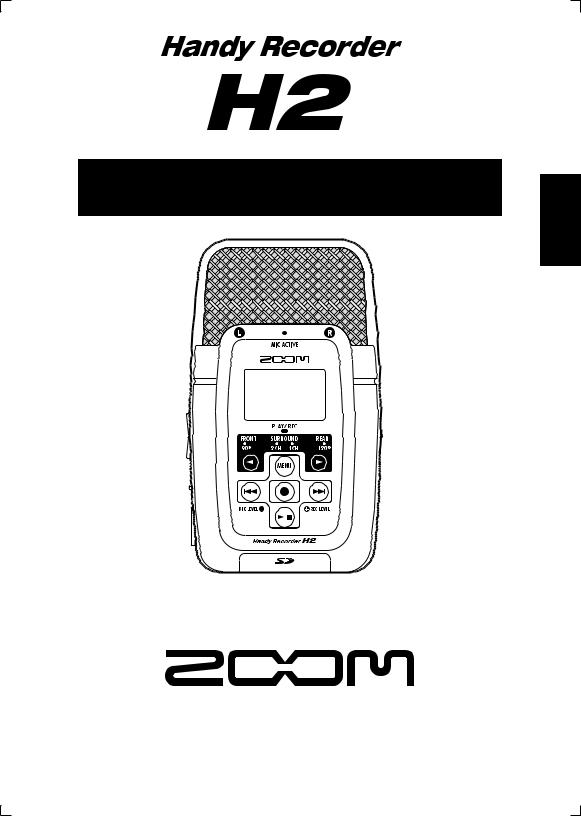
Operation Manual
English
© ZOOM Corporation
Reproduction of this manual, in whole or in part, by any means, is prohibited.
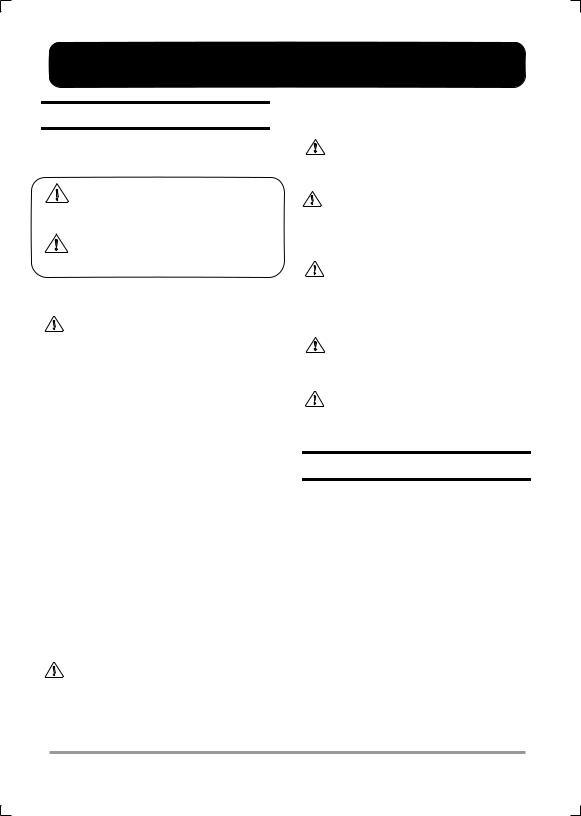
SAFETY PRECAUTIONS / Usage Precautions
SAFETY PRECAUTIONS
In this manual, symbols are used to highlight warnings and cautions for you to read so that accidents can be prevented. The meanings of these symbols are as follows:
|
This symbol indicates explanations about extremely |
|
dangerous matters. If users ignore this symbol and |
Warning |
handle the device the wrong way, serious injury or |
|
death could result. |
|
This symbol indicates explanations about dangerous |
|
matters. If users ignore this symbol and handle the |
Caution |
device the wrong way, bodily injury and damage to |
|
the equipment could result. |
Please observe the following safety tips and precautions to ensure hazard-free use of the H2.
Power requirements
Since power consumption of this unit is fairly high, we Warning recommend the use of an AC adapter whenever
possible. When powering the unit from batteries, use only alkaline types.
[AC adapter operation]
•Be sure to use only an AC adapter which supplies 9 V DC, 300 mA and is equipped with a "center minus" plug (Zoom AD-0006). The use of an adapter other than the specified type may damage the unit and pose a safety hazard.
•Connect the AC adapter only to an AC outlet that supplies the rated voltage required by the adapter.
•When disconnecting the AC adapter from the AC outlet, always grasp the adapter itself and do not pull at the cable.
•During lightning or when not using the unit for an extended period, disconnect the AC adapter from the AC outlet.
[Battery operation]
•Use two conventional IEC R6 (size AA) batteries (alkaline).
•The H2 cannot be used for recharging.
•Pay close attention to the labelling of the battery to make sure you choose the correct type.
•When not using the unit for an extended period, remove the batteries from the unit.
•If battery leakage has occurred, wipe the battery compartment and the battery terminals carefully to remove all remnants of battery fluid.
•While using the unit, the battery compartment cover should be closed.
Environment
To prevent the risk of fire, electric shock or Warning malfunction, avoid using your H2 in environments
where it will be exposed to:
•Extreme temperatures
•Heat sources such as radiators or stoves
•High humidity or moisture
•Excessive dust or sand
•Excessive vibration or shock
Handling
• Never place objects filled with liquids, such as vases, on
Warning |
the H2 since this can cause electric shock. |
|
•Do not place naked flame sources, such as lighted candles, on the H2 since this can cause fire.
•The H2 is a precision instrument. Do not exert undue pressure on the keys and other controls. Also take care not
Caution |
to drop the unit, and do not subject it to shock or excessive |
|
pressure. |
•Take care that no foreign objects (coins or pins etc.) or liquids can enter the unit.
Caution
Connecting cables and input and output jacks
You should always turn off the power to the H2 and all other equipment before connecting or disconnecting any cables. Also make sure to disconnect all connection cables and the power cord before moving the H2.
Alterations
Never open the case of the H2 or attempt to modify the Warning product in any way since this can result in damage to
the unit.
|
Volume |
Caution |
Do not use the H2 at a loud volume for a long time |
since this can cause hearing impairment. |
Usage Precautions
Electrical interference
For safety considerations, the H2 has been designed to provide maximum protection against the emission of electromagnetic radiation from inside the device, and protection from external interference. However, equipment that is very susceptible to interference or that emits powerful electromagnetic waves should not be placed near the H2, as the possibility of interference cannot be ruled out entirely.
With any type of digital control device, the H2 included, electromagnetic interference can cause malfunctioning and can corrupt or destroy data. Care should be taken to minimize the risk of damage.
Cleaning
Use a soft, dry cloth to clean the H2. If necessary, slightly moisten the cloth. Do not use abrasive cleanser, wax, or solvents (such as paint thinner or cleaning alcohol), since these may dull the finish or damage the surface.
Please keep this manual in a convenient place for future reference.
2 |
ZOOM H2 |

Contents
SAFETY PRECAUTIONS / |
|
Usage Precautions ................................ |
2 |
What the H2 Can Do ................................ |
5 |
Parts of the H2 ......................................... |
8 |
Getting Connected ................................. |
10 |
Operation on Battery Power ................. |
11 |
About SD Cards ...................................... |
11 |
Recording ............................................... |
12 |
Setup .................................................... |
12 |
Power-on ............................................. |
13 |
Selecting the operation mode ............. |
14 |
Setting the input sensitivity and |
|
recording level.................................... |
15 |
Recording and playback ..................... |
17 |
Power-off ............................................. |
17 |
Stereo Mode Recording ........................ |
18 |
About the stereo mode ....................... |
18 |
Setup example (1): |
|
Built-in mics ...................................... |
19 |
Setup example (2): |
|
External mic ...................................... |
20 |
Setup example (3): |
|
External component .......................... |
20 |
Selecting the mic pattern for |
|
the built-in mics ................................ |
21 |
Recording ............................................ |
23 |
Playback .............................................. |
25 |
4-Channel Mode Recording .................. |
27 |
About the 4-channel mode ................. |
27 |
Setup examples ................................... |
29 |
Recording ............................................ |
29 |
Playback .............................................. |
31 |
Adjusting the front/rear/left/right balance |
|
(3D panning) ...................................... |
32 |
Convenient Recording Functions ........ |
35 |
Selecting the recording mode ............ |
35 |
Using the AGC/compressor/ |
|
limiter function .................................. |
37 |
Attenuating the low frequencies ......... |
38 |
Using the auto record function ........... |
39 |
Using the pre-record function ............ |
42 |
Recording a stereo signal in mono |
|
(stereo mode only) ........................... |
43 |
Convenient Playback Functions .......... |
45 |
Selecting the play mode ..................... |
45 |
Using the A-B repeat function ............ |
46 |
File Operations ...................................... |
47 |
Files and folders .................................. |
47 |
Selecting a folder |
|
(stereo mode only) ........................... |
48 |
Selecting a file ..................................... |
48 |
Viewing file information ....................... |
49 |
Assigning a name to a file |
|
(stereo mode only) ........................... |
50 |
Deleting a file ....................................... |
52 |
Dividing a file |
|
(stereo mode only) ............................ |
53 |
Raising the overall file level |
|
(normalize function) .......................... |
54 |
Converting a WAV file into an MP3 file |
|
(stereo mode only) ............................ |
55 |
Converting a 4-channel file pair to |
|
a stereo file (4-channel mode only) |
|
............................................................ |
57 |
Checking the mark list ........................ |
59 |
SD Card Operations .............................. |
60 |
Checking the remaining time on |
|
the card ............................................. |
60 |
Formatting a card ................................ |
61 |
SD card dropout errors ....................... |
62 |
ZOOM H2 |
3 |

Contents
Tuning an Instrument ............................ |
63 |
Using the chromatic tuner ................... |
63 |
Using the dedicated guitar/ |
|
bass tuner .......................................... |
64 |
Adjusting the reference pitch of |
|
the tuner ............................................ |
66 |
Using the Metronome Function ............ |
67 |
Switching the metronome |
|
/pre-count on and off ........................ |
67 |
Making metronome/ |
|
pre-count optional settings .............. |
69 |
Connecting the H2 to a Computer ....... |
71 |
Using the H2 as a card reader ............ |
71 |
Using the H2 as an audio interface ..... |
73 |
Other Functions ..................................... |
78 |
Setting the date and time .................... |
78 |
Using the monitor function.................. |
79 |
Supplying power to an external mic |
|
(stereo mode only) ........................... |
80 |
Adjusting the display contrast ............ |
81 |
Controlling the backlight on/off setting |
|
........................................................... |
82 |
Specifying the battery type ................. |
83 |
Making settings for the key |
|
hold function ..................................... |
84 |
Updating the system software............ |
84 |
Specifications ......................................... |
86 |
Troubleshooting ..................................... |
88 |
Error Messages ...................................... |
89 |
Index ........................................................ |
90 |
•Windows, Windows XP, and Windows Vista are registered trademarks of Microsoft Corporation.
•Macintosh and MacOS are registered trademarks of Apple.
•The SD symbol and SDHC symbol are trademarks.
•The use of MPEG Layer-3 audio compression technology is licensed from Fraunhofer IIS and Sisvel SpA.
•All other trademarks, product names, and company names mentioned in this documentation are the property of their respective owners.
4 |
ZOOM H2 |

What the H2 Can Do
Thank you for selecting the ZOOM Handy Recorder H2 (subsequently referred to simply as the "H2"). The H2 is a nifty SD card based recorder with two operation modes for 2-channel (stereo) or 4-channel recording. This section describes the main features of this product.
Stereo mode recording (→ p. 12, p. 18)
In stereo mode, you use the built-in mics or another source such as an external mic or a CD player to record a 2-channel stereo signal.
■ Using the built-in mics
The built-in mics allow you to record sound coming either from the front panel or the rear panel direction of the unit. The directivity angle covered by the mics is fixed to 90 degrees for the front side mics and 120 degrees for the rear side mics. Choose the side that is best suited for a given recording situation. Some examples for using the builtin mics are shown below.
● Solo vocals or a single instrument
Point the front panel of the H2 towards the sound source. The 90 degree directivity angle will help in excluding unwanted sounds.
sound source. The 120 degree directivity angle will help in capturing the ambience of the venue.
● Recording front and back simultaneously
By positioning the H2 upright, it is possible to record sound coming both from the front and back of the unit.
This is great for a conversation between two people or recording an instrument and a singer facing each other.
●Recording a band or capturing sounds in the field
Point the rear panel of the H2 towards the
■ Using an external mic
Simply connect the microphone to the [EXT MIC IN] jack and place it near the sound
ZOOM H2 |
5 |

What the H2 Can Do
source. If a mono mic is used, only the left channel signal will be recorded.
■ Recording other external sources
The [LINE IN] jack lets you connect a CD player or other external component, for easy line recording of its output signal.
4-channel mode recording (→ p. 27)
In 4-channel mode, the built-in mics pick up sources in stereo both from the front and rear panel direction and create a 4-channel recording. The front/back/left/right level balance can be adjusted later, and for playback the result can be mixed into a 2-channel (stereo) signal.
Audio files created in 4-channel mode can also serve as source material for a surround sound encoder. This makes it possible to produce surround sound audio that can be played on a home entertainment type 5.1ch surround sound system.
■ Recording a band rehearsal
When the members of the band are facing each other, the H2 can be placed in the middle to record sound coming from the front and rear.
H2
The 4-channel content is mixed into 2 channels (stereo) for playback.
The front/back/left/right balance can easily be adjusted after the recording is made.
■ Field recording
Position the H2 upright and have the front panel face the main sound source.
6 |
ZOOM H2 |

What the H2 Can Do
Metronome function (→ p. 67)
The built-in metronome function of the H2 is convenient for use as a guide rhythm during recording. During playback, the metronome sound can be turned off. Another useful application of the metronome is for providing a pre-count before recording.
Tuner function (→ p. 63)
The tuner function of the H2 makes it easy to tune instruments anywhere. Besides the universally applicable chromatic tuning, standard tuning for guitar and bass as well as various special tuning modes are also available.
Exchanging audio files between a computer and the H2 (→ p. 71)
You can copy files that you have recorded on the H2 to a computer, for processing with waveform editor software or burning to CD. Copying edited files back to the H2 for playback is also a cinch.
Audio files
Use as audio interface (→ p. 73)
The H2 can serve as audio interface for a computer, letting you directly record the input signal of the H2 on the computer, or play the computer output signal via the H2.
File operations (→ p. 47)
Audio files stored on SD card can be deleted, split into multiple files, and various information about the files can be displayed.
SD card operations (→ p. 60)
You can initialize SD cards in the H2 and check how much recording time is left on a card.
ZOOM H2 |
7 |
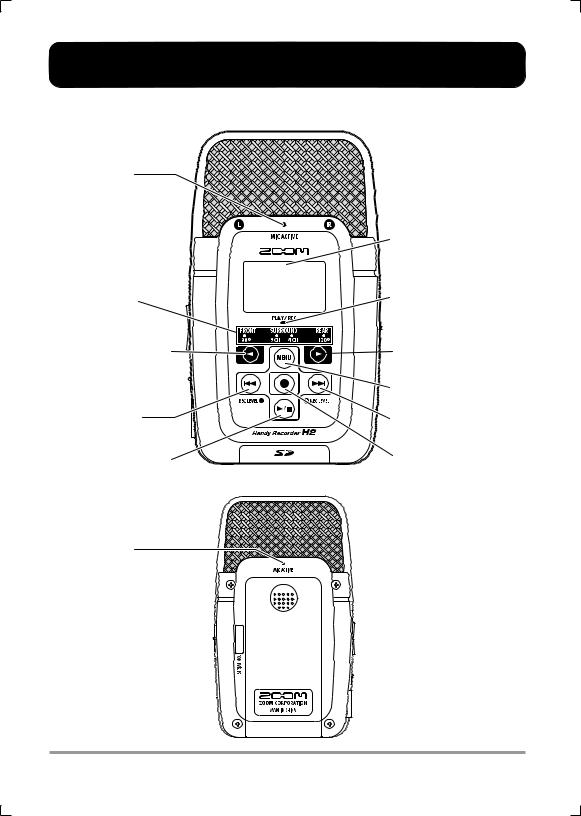
Parts of the H2
Front panel
[MIC ACTIVE] indicator
*Flashes if the front-side mic signal is distorted.
Mic pattern indicators
 (MIC PATTERN) key
(MIC PATTERN) key
 (REW) key
(REW) key
 (PLAY/PAUSE) key
(PLAY/PAUSE) key
Rear panel
[MIC ACTIVE] indicator
*Flashes if the rear-side mic signal is distorted.
Display
[PLAY/REC] indicator

 (MIC PATTERN) key
(MIC PATTERN) key
 (MENU) key
(MENU) key
 (FF) key
(FF) key
 (REC) key
(REC) key
 Battery compartment cover
Battery compartment cover
8 |
ZOOM H2 |
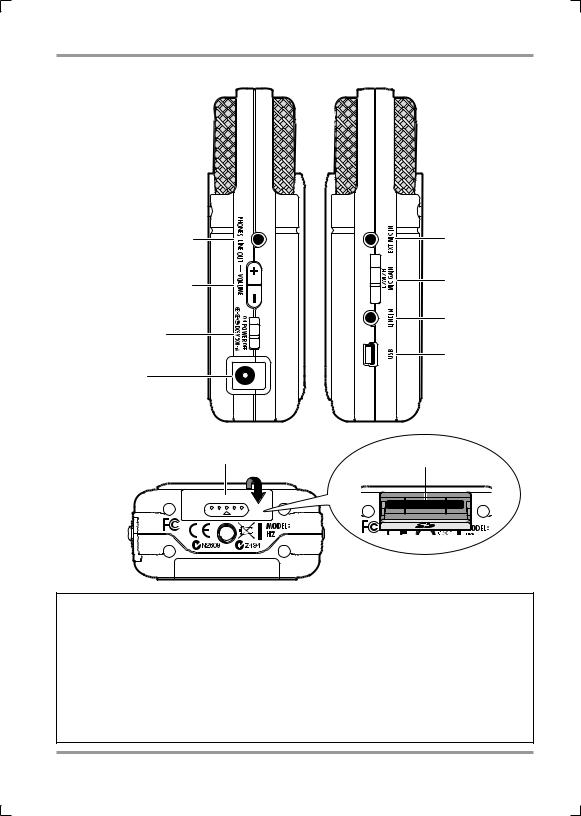
Parts of the H2
Left side panel |
Right side panel |
[PHONES/LINE OUT] |
[EXT MIC IN] |
|
jack |
jack |
|
VOLUME [+]/[-] keys |
[MIC GAIN] |
|
switch |
||
|
||
|
[LINE IN] jack |
|
[POWER] switch |
|
|
|
[USB] port |
|
[DC 9V] jack |
|
Bottom panel
[SD CARD] slot cover [SD CARD] slot
Open |
Internal clock date/time setting
The H2 has an internal clock that is used for time stamping of files created during recording. When you turn the H2 on for the first time, a message asking you to set the date/time appears. Follow the instructions in the section "Setting the date and time" on page 78.
Note that if you skip this step, the clock will be set to the default (2007/01/01).
ZOOM H2 |
9 |
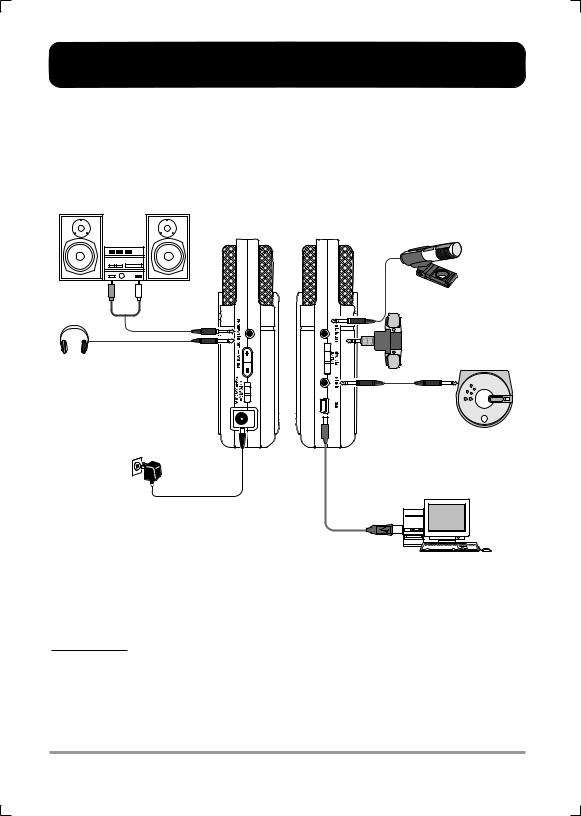
Getting Connected
Make connections to other equipment such as microphones and audio components as shown below.
To monitor the output of the H2 using a stereo system, connect a Y cable to the [PHONES/LINE OUT] jack (stereo mini phone jack) and adjust the volume with the VOLUME [+]/[-] keys.
Monitor system
H2 Left side panel
Headphones
To monitor the output of the H2 using headphones, connect the phones to the [PHONES/LINE OUT] jack (stereo mini phone jack) and adjust the volume with the VOLUME [+]/[-] keys.
AC adapter
To operate the H2 on AC power, be sure to use only the supplied AC adapter. Using a different adapter can lead to damage.
NOTE
To use an external microphone, connect the mic to the [EXT MIC IN] jack (stereo mini phone jack). Plug-in power type microphones are also supported (p.80).
H2 Right side
panel Stereo mic
Plug-in power type stereo mic
CD player
To record the output signal of a CD player or similar, connect it to the [LINE IN] jack (stereo mini phone jack).
Computer
When the H2 is connected to a computer via the [USB] port (mini USB), it can be used as audio interface for the computer, and audio files stored on the SD card in the H2 can be transferred to the computer.
•To use the built-in mics, disconnect any equipment from the [EXT MIC IN] jack or [LINE IN] jack. If anything is connected to these jacks, the built-in mics are deactivated.
•If equipment is connected both to the [EXT MIC IN] jack and [LINE IN] jack, the [LINE IN] jack has priority.
10 |
ZOOM H2 |

Operation on Battery Power
The H2 can be powered from batteries which must be purchased separately. Insert the batteries as
follows.
1.Open the battery compartment cover.
2.Insert two IEC R6 (size AA) batteries.
HINT
Use alkaline/oxyride batteries or rechargeable nickel-hydride batteries.
3.Close the battery compartment cover.
NOTE
•When the unit is operated on batteries, the indication "Low Battery!" will appear on the display when the batteries are exhausted. In this case, turn the unit off and replace the batteries as soon as possible with fresh ones.
•When the unit is operated on batteries, do not open the battery compartment cover while the unit is on, because this will cut power and may lead to data loss.
ZOOM H2 |
11 |
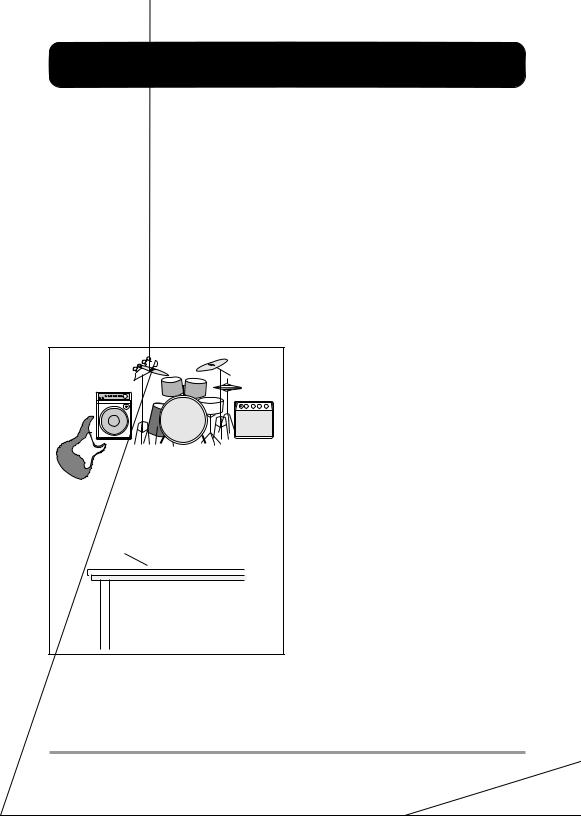
12 |
ZOOM H2 |
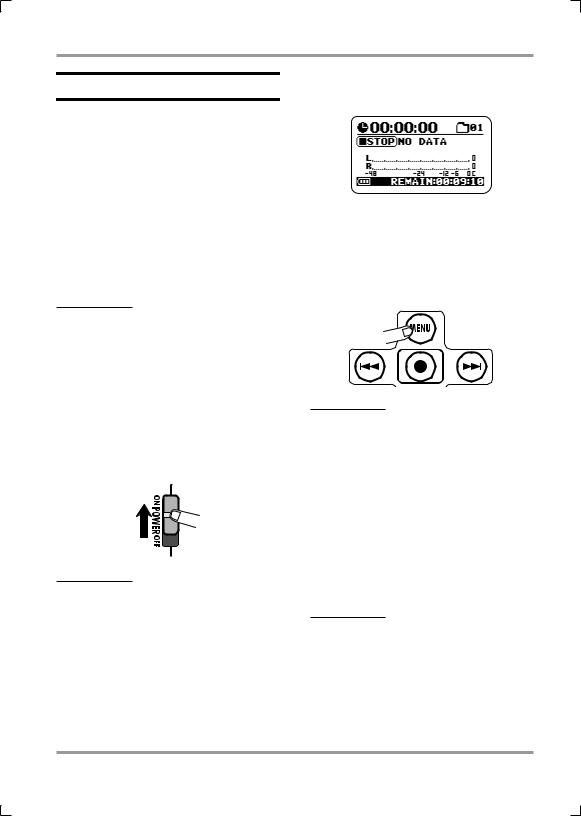
Recording
Power-on
Use the following procedure to turn the H2 on.
1. Insert a SD card into the H2.
Verify that power to the H2 is off. Then insert the SD card into the [SD CARD] slot (→ p. 11).
Verify that a monitor system or headphones are connected to the [PHONES/LINE OUT] jack of the H2.
HINT
When using an external monitor system, make sure that the volume is fully turned down and power is off.
2.Turn power on in the order H2 → monitor system.
To turn the H2 on, slide the [POWER] switch into the ON position. Next, turn power to the monitor system on and adjust the volume.
NOTE
•If the indication "No Card" appears when you turn the H2 on, no SD card was detected. Make sure that the SD card is inserted properly.
•If the indication "Format Card?" appears when you turn the H2 on, the inserted SD card has not been initialized. To initialize (format) the card, use the 3 (REW)/2 (FF) keys to move the cursor to "YES" and press the 5 (REC) key.
When the H2 starts up, the following screen is shown.
This is called the "top screen". From here, you can access the various functions of the H2. If another screen is currently shown, press the 4 (MENU) key repeatedly until the above screen appears.
HINT
The top screen will look slightly different, depending on the currently selected mode (stereo mode or 4-channel mode).
The H2 has an internal clock that is used for time stamping of files created during recording. When you turn the H2 on for the first time, a message asking you to set the date/time appears. Follow the instructions in the section "Setting the date and time" on page 78.
NOTE
If you skip this step, all files will be time stamped with the default "2007/01/01".
ZOOM H2 |
13 |

Recording
H2 |
H2 |
FRONT 90 |
REAR 120 |
Stereo recording of sound sources |
Stereo recording of sound sources |
located in front of the H2, within a |
located in rear of the H2, within a |
90-degree range |
120-degree range |
14 |
ZOOM H2 |
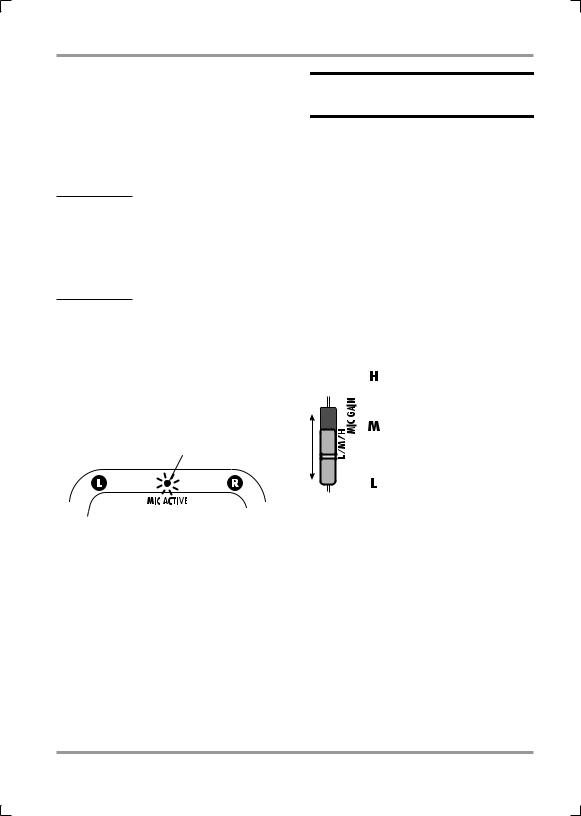
Recording
degree angle), depending on the width of the sound source and the distance to it. For details on mic patterns, see page 21.
When one of the above mic patterns is chosen, the operation mode automatically becomes stereo (2-channel).
NOTE
When the H2 is in the playback, recording, or recording standby condition, or when something is connected to the [EXT MIC IN] jack or [LINE IN] jack, the mic pattern setting cannot be changed.
HINT
•The [MIC ACTIVE] indicator on the front panel and rear panel of the H2 shows which mic is currently selected.
•If the sound level as picked up by the front or rear mics is too high, causing signal distortion, the respective [MIC ACTIVE] indicator flashes.
[MIC ACTIVE] indicator
Lit
H2 front panel
Setting the input sensitivity and recording level
For best results, the input sensitivity and the recording level must be set to appropriate values.
1.Set the sensitivity of the built-in mics.
Setting the input sensitivity means adjusting the gain of the input section of the H2, so that the signal from the built-in mics or from the [EXT MIC IN] jack can be recorded with minimal noise and distortion.
The [MIC GAIN] switch on the right side panel of the H2 is used for setting the input sensitivity.
[MIC GAIN] switch
Use this position if the sound source is at a distance from the H2 or if its level is low.
Use this position for recording an acoustic guitar or other instruments with relatively low volume.
Use this position if the sound source is close to the H2 or if you are recording a band performance or other loud sound source.
When you change the position of the [MIC GAIN] switch, the new setting will be shown on the display for about two seconds (for example "MIC GAIN LOW").
Select the position of the [MIC GAIN] switch so that the [MIC ACTIVE] indicator on the front panel or rear panel does not flash when the volume of the sound source is at maximum. If the indicator flashes, the recording will be distorted.
ZOOM H2 |
15 |

Recording
[MIC ACTIVE] indicator
Flash
H2 front panel
2.Set the H2 to the recording standby condition and adjust the recording level.
Adjusting the recording level means adjusting the level of the signal as recorded on the SD card. To do this, verify that the stereo mode top screen is shown, and press the 5 (REC) key.
To adjust the recording level, use the 3 (REW)/2 (FF) keys.
When you press either of these keys once, the current recording level setting is shown on the display.
Recording level setting
The H2 is now in the recording standby condition and the [PLAY/REC] indicator on the front panel flashes in red.
0 (dB)
When you continue to press the key, the recording level changes. Set the level as high as possible but so that the meter indication does not exceed 0 (dB) during the loudest passages. The setting range is 0 – 127.
[PLAY/REC] indicator
Flash
The input signal level is shown by the level meters on the display, and the sound of the input signal can be monitored via the [PHONES/LINE OUT] jack.
3.Cancel the recording standby condition.
To cancel the recording standby condition, press the 1 (PLAY/PAUSE) key.
Input signal level
16 |
ZOOM H2 |
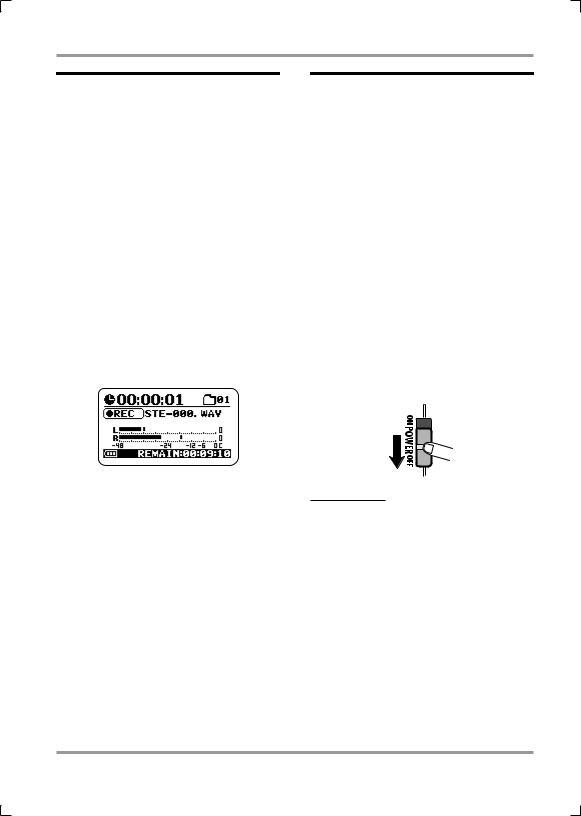
Recording
Recording and playback |
Power-off |
|
|
|
|
The steps for recording and playback are as follows.
1.Set the H2 to the recording standby condition.
With the stereo mode top screen shown on the display, press the 5 (REC) key to set the H2 to recording standby.
2. Start recording.
Press the 5 (REC) key once more. The [PLAY/REC] indicator on the front panel is now constantly lit in red, and the counter on the display indicates the progress of the recording.
3. Stop recording.
To stop recording, press the 5 (REC) key. The [PLAY/REC] indicator goes out. When you stop recording, the counter of the H2 returns to the beginning, and you can start playback from that point.
4. Check the recording.
To check the recorded content, press the 1 (PLAY/PAUSE) key. During playback, the [PLAY/REC] indicator is lit in green. Press the key once more to stop playback.
Use the following procedure to turn the H2 off.
1.Turn the volume of the monitor system down.
2.Turn power off in the order monitor system → H2.
After verifying that the monitor system is off, turn the H2 off by sliding the [POWER] switch into the OFF position.
The indication "GoodBye See You!" is shown briefly on the display before the unit goes off. All settings and other information are automatically stored on the SD card at this point.
NOTE
Always use the [POWER] switch to turn the H2 on and off. Never disconnect the AC adapter while power is on because this can lead to data loss.
ZOOM H2 |
17 |
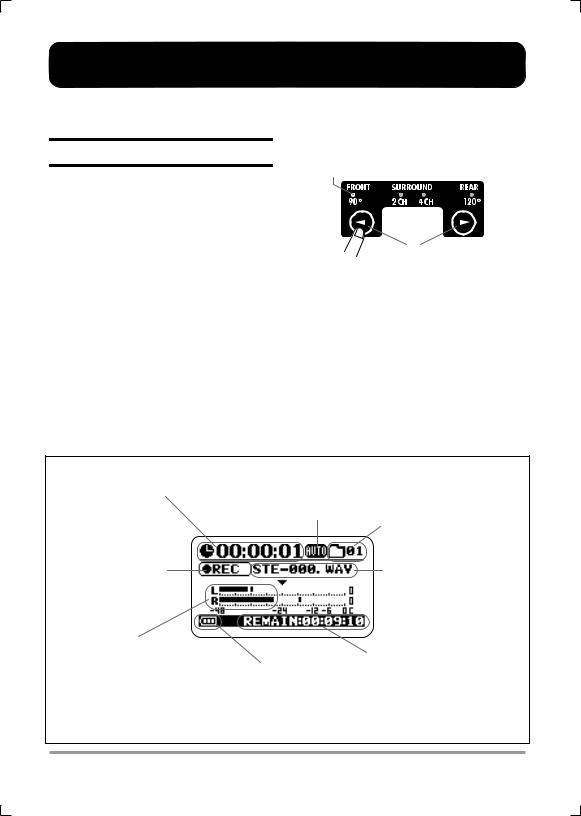
Stereo Mode Recording
This section explains in detail how to record in stereo mode.
About the stereo mode
In stereo mode, the signal from the built-in mics, an external mic, a CD player or other external component is recorded on two channels as a stereo signal. When the H2 is in stereo mode, the operation steps are as follows.
●Recording the signal from the built-in mics
Select a mic pattern (recording direction and angle) other than SURROUND 4CH. (For details on mic patterns, see page 21.) To do this, use the 7/6(MIC PATTERN) keys to cause an indicator other than SURROUND 4CH to light up.
Indicator for selected mic pattern lights up

 (MIC PATTERN) keys
(MIC PATTERN) keys
●Recording the signal from an external mic or an external component
Connect the device to the [EXT MIC IN] jack or [LINE IN] jack. When a cable is plugged into one of these jacks, the built-in mics are turned off.
The illustration shows the stereo mode top screen. The screen gives access to the information explained below.
Counter |
Option function symbol |
Shows the playback time of the current file or the recording time in hours/minutes/seconds.
Recorder status
Shows the current operation status of the recorder. There are five different indications for playback, pause, stop, recording standby, and recording.
When repeat playback or auto record is active, the respective symbol is shown here.
Level meters
Indicate the current input level or output level. At the rightmost end of the scale is a clip indicator which lights up when signal clipping (leading to distortion and sound breakup) occurs. If clipping has occurred at least once during playback or recording, the clip indicator remains lit until the end of playback/recording.
Battery indicator
Shows the battery status.
Folder number
The folder (hierarchical unit) used for storing recorded files is shown here (01 - 10).
File name
Normally, the name of the file that is played back is shown here. During recording standby and recording, the name of the file used for recording is shown.
Remaining recording time
Indicates the available time for recording, according to the currently selected recording mode (file format, quantization, sampling frequency).
18 |
ZOOM H2 |
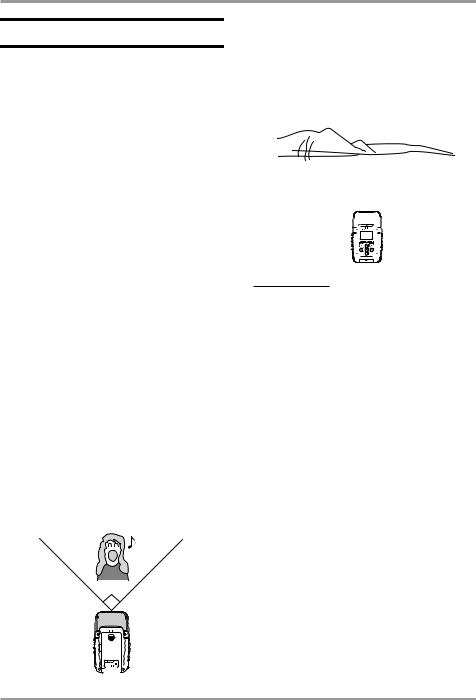
Stereo Mode Recording
Setup example (1): Built-in mics
When using the built-in mics to record in stereo mode, a sound source located in the front or rear direction of the H2 can be recorded. By selecting the respective mic pattern, the directivity angle is set to 90 or 120 degrees (→ p. 21). It is also possible to place the H2 in the center and record sound from the front and back directions.
To perform stereo recording of sound from the front or rear direction, the respective panel of the H2 should normally face the sound source.
The supplied desktop stand can be used to place th e H 2 o n a tabl e o r othe r fla t surface . Alternatively, the supplied mic clip adapter is convenient to mount the H2 on a mic stand. Directly placing the H2 on the floor or on a table should be avoided, because footsteps or undesired vibrations can be transmitted to the unit.
■Recording solo vocals or a single instrument
The mic pattern setting also determines the directivity angle. Selecting "FRONT 90" and using the front side mics may be preferable in order to focus on the source and exclude unwanted sounds. The distance between sound source and H2 should be about 10 to 30 cm for on-mic recordings and 50 cm to 1.5 meters for off-mic recordings.
90 deg.
 H2
H2
■Recording a live band or making field recordings
Selecting "REAR 120" and using the rear side mics may be preferable in order to cover a wider area and capture the ambience of the location.
NOTE
•If you hold the H2 in your hand during field recording, scratching noises may occur which will detract from the recording. To avoid this, mount the H2 on the supplied mic clip adapter and grasp the adapter using a glove.
•If wind hitting the mics is causing pop noise, attach the supplied windscreen.
■Recording front and back simultaneously
By positioning the H2 upright, it is possible to record sound coming both from the front and back of the unit. This is useful for example to record a conversation between two people or an instrument and a singer facing each other.
ZOOM H2 |
19 |
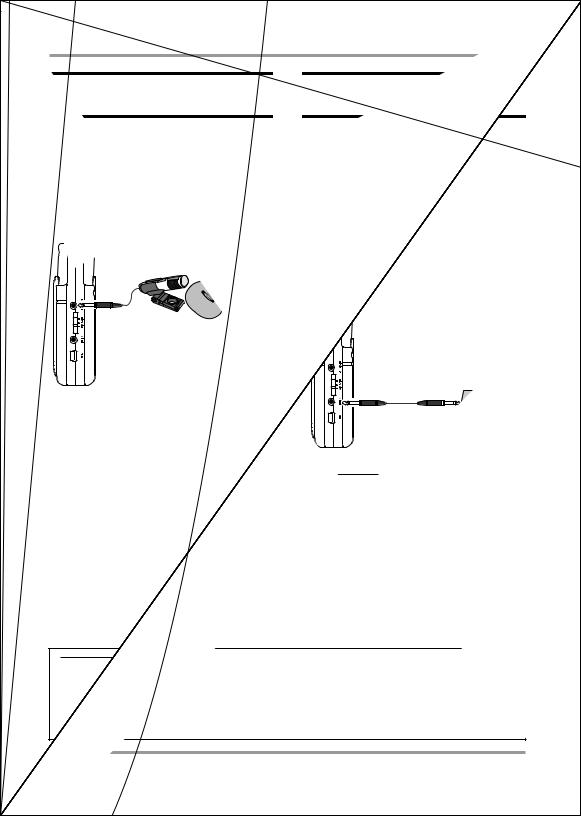
Stereo Mode Recording
Setup example (2): External mic
Setup example (3): External component
To use an external mic for recording, connect the mic to the [EXT MIC IN] jack. If a mono mic is used, only the left channel signal will be recorded.
H2
External mic
[EXT MIC IN] jack
To record the signal of an external source component such as a CD player, connect the output of the component to the [LINE IN] jack. Use the supplied Y cable or a cable with a stereo mini phone plug at both ends. Note that direct input of the signal from instruments such as an electric guitar or bass is not supported.
H2
CD player
[LINE IN] jack
HINT
• If anything is plugged into the [EXT MIC IN] jack or [LINE IN] jack, the built-in mics are deactivated.
• If equipment is connected both to the [EXT MIC IN] jack and [LINE IN] jack, the [LINE IN] jack has priority.
Glossary
On-mic/Off-mic
On-mic refers to recordings made with the microphone close to the sound source, while off-mic is a recording technique that puts more distance between sound source and microphone, to capture ambience and room reverberations as well.
20 |
ZOOM H2 |
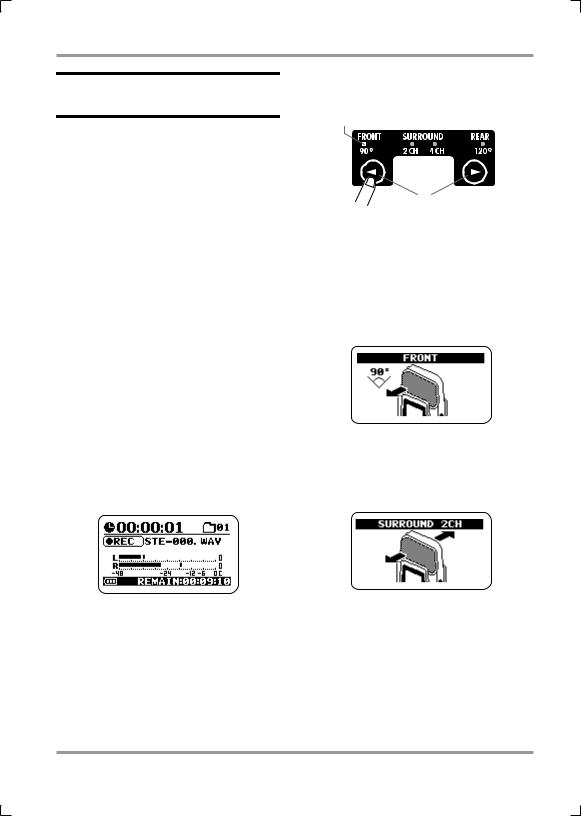
Stereo Mode Recording
Selecting the mic pattern for the built-in mics
When making a recording with the built-in mics of the H2, sound is not simply picked up from all directions. Rather, you can control the direction and the angle from which sound is picked up. This is called a "mic pattern". The H2 offers a choice of 4 mic patterns. 3 of these can be used in stereo mode.
To select a mic pattern, proceed as follows.
1.Verify that nothing is connected to the [EXT MIC IN] jack or [LINE IN] jack.
If anything is plugged into these jacks, the built-in mics will not operate, and the mic pattern cannot be selected.
2.Verify that the top screen is shown on the display.
If another screen is shown, the mic pattern cannot be selected. Press the 4 (MENU) key repeatedly until the top screen appears.
3. Select the mic pattern.
Use the 7/6 (MIC PATTERN) keys to cause the indicator for the desired pattern to light. When a pattern is selected, its name is briefly shown on the display as well . According to the selected mic pattern, the recording mode will also change (stereo mode
or 4-channel mode).
Indicator for selected mic pattern lights up

 (MIC PATTERN) keys
(MIC PATTERN) keys
Available patterns and corresponding modes are as follows.
● FRONT 90º (stereo mode)
Sources located within a 90-degree angle on the front side of the unit are recorded in stereo.
● SURROUND 2CH (stereo mode)
Sound from the front side and the rear side of the unit is recorded in 2 channels.
ZOOM H2 |
21 |
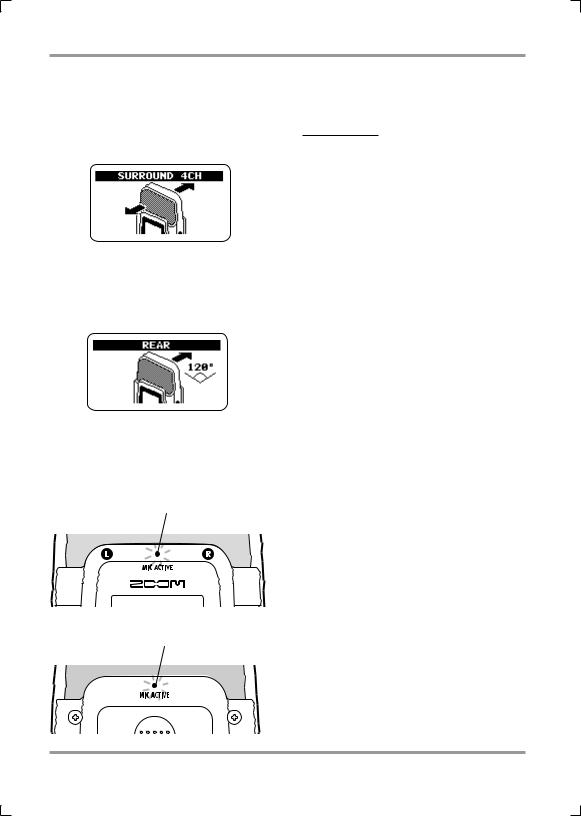
Stereo Mode Recording
● SURROUND 4CH (4-channel mode)
Stereo sound from the front side and stereo sound from the rear side of the unit is recorded in 4 channels. The H2 switches to 4-channel mode (→ p. 27).
● REAR 120º (stereo mode)
Sources located within a 120-degree angle on the rear side of the unit are recorded in stereo.
Which set of mics is currently active is indicated by the [MIC ACTIVE] indicator on the front panel and rear panel of the H2.
[MIC ACTIVE] indicator
H2 front panel |
Lit |
|
[MIC ACTIVE] indicator
H2 rear panel Lit
When you select SURROUND 2CH or 4CH, both the front and rear panel [MIC ACTIVE] indicator will be lit.
NOTE
•The mic pattern setting only applies to the built-in mics. It has no effect when an external mic is used.
•When anything is plugged into the [EXT MIC IN] jack or [LINE IN] jack, the built-in mics are deactivated and all mic pattern indicators are out.
•While the H2 is in the playback, recording, or recording standby condition, the mic pattern setting cannot be changed.
22 |
ZOOM H2 |

Stereo Mode Recording
Recording
To record in stereo mode, proceed as follows.
HINT
In the initial condition, the H2 is set up to record stereo WAV files (16 bit quantization, sampling frequency 44.1 kHz) in stereo mode. The settings for file format, quantization, and sampling frequency can be changed (→ p. 35).
1.Bring up the stereo mode top screen.
2.Activate the source to record.
The H2 can record from the built-in mics, from an external mic connected to the [EXT MIC IN] jack or from an external component connected to the [LINE IN] jack.
●Recording from the built-in mics
Verify that nothing is connected to the [EXT MIC IN] jack or [LINE IN] jack. If anything is plugged into these jacks, the built-in mics will not operate.
●Recording from an external mic or external component
Connect the external mic to the [EXT MIC IN] jack or the external component to the [LINE IN] jack. Note that the [LINE IN] jack has priority if equipment is connected both to the [EXT MIC IN] jack and [LINE IN] jack.
3. Adjust the input sensitivity.
When using the built-in mics or an external mic connected to the [EXT MIC IN] jack, set the input sensitivity to a suitable value using the [MIC GAIN] switch.
Make the setting so that the [MIC ACTIVE]
indicator on the front panel or rear panel does not flash when the volume of the sound source i s a t m a x i m u m . F o r i n f o r m a t i o n o n recommended [MIC GAIN] switch settings, see page 15.
HINT
Keep in mind that the recorded content will be distorted if the [MIC ACTIVE] indicator is flashing.
4.Set the H2 to the recording standby condition.
Press the 5 (REC) key so that [PLAY/REC] indicator on the front panel flashes in red. The current input level is indicated by the level meters, and the input signal can be monitored via the [PHONES/LINE OUT] jack. The name of the file that will be created is also shown on the display.
Input signal level
File created by this recording operation
HINT
•By changing a setting of the H2, it is possible to always monitor the input signal,
also while the unit is not in the recording standby condition (→ p. 79).
•In stereo mode, a new file is created for every recording operation, and a file name is automatically assigned, using the pattern "STE-xxx.WAV" or "STE-xxx.MP3" (where
xxx is a number from 000 to 999). The file name can be changed later (→ p. 50).
ZOOM H2 |
23 |
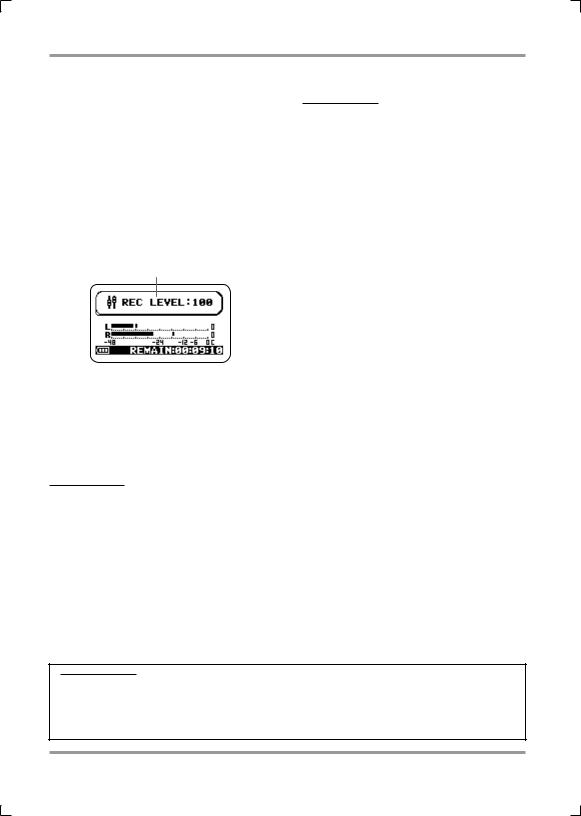
Stereo Mode Recording
5. Adjust the recording level.
To adjust the recording level, use the 3 (REW)/2 (FF) keys. When you press one of these keys once, the current recording level setting is shown on the display. Pressing the key further will change the setting.
Set the level as high as possible but so that the meter indication on the display does not exceed 0 (dB) during the loudest passages. The setting range is 0 – 127.
Recording level
To record the signal from an external component such as a CD player connected to the [LINE IN] jack, control the recording level by adjusting the volume setting at the external component.
HINT
To cancel the recording standby condition, press the 1 (PLAY/PAUSE) key.
6. Start recording.
When you press the 5 (REC) key once more in the recording standby condition, the [PLAY/REC] indicator on the front panel stays constantly lit in red. The current position
in the recording is indicated by the counter.
HINT
•Recording always starts at the beginning of a new file. It is not possible to resume recording from part way into a file.
•By pressing the 1 (PLAY/PAUSE) key while a recording is in progress, you can set a BWF compatible cue point. When you press the 1 (PLAY/PAUSE) key, the indication "MARKxx" (where xx is a number from 1 to
99)appears on the display, and a mark (cue point) with the corresponding number is created.
•You can check the time (hours:minutes: seconds) of marks that have been set (→p.
7. Stop the recording.
To terminate the recording, press the 5 (REC) key once more so that the [PLAY/ REC] indicator goes out. When the recording is stopped, the counter returns to the beginning and the file is ready for playback.
8. Check the recording.
To play the recorded content, press the 1 (PLAY/PAUSE) key. To stop playback, press the 1 (PLAY/PAUSE) key once more.
If you redo the recording, the old file will not be overwritten. Rather, a new file is created each time. For information on how to delete files that are no longer needed, see page 52.
Glossary
BWF (Broadcast Wave Format)
An extended WAV file format used primarily in broadcasting applications. Information about the file creation date and cue points are embedded in the file.
24 |
ZOOM H2 |
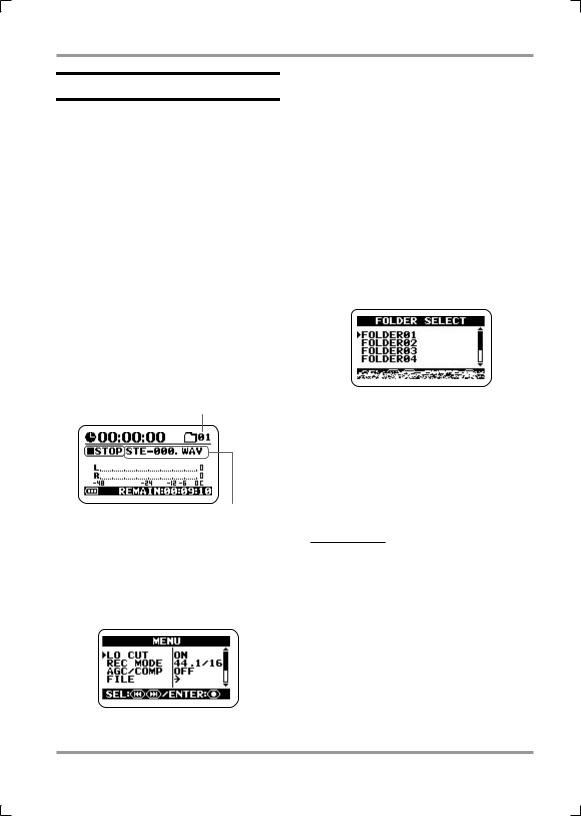
Stereo Mode Recording
Playback
This section explains how to play back a file recorded in stereo mode.
In stereo mode, each recording operation will result in one stereo file (WAV or MP3 format). These files are stored in the currently selected folder (01 – 10) on the inserted SD card. To select a recorded stereo file for playback, proceed as follows.
1.Bring up the stereo mode top screen on the display.
The file whose name is shown in the center of the display is the one that will be played back. Only files located in the currently selected folder can be selected for playback.
Number of currently selected folder
Name of currently selected file
2.Select the folder which contains the file to play.
To select a folder, press the 4 (MENU) key to bring up the following screen.
This screen is the main menu which gives access to various setting menus.
At the main menu screen, use the 3 (REW)/ 2 (FF) keys to move the cursor (R symbol) to the desired item and press the 5 (REC) key to open the setting screen for that item. By pressing the 4 (MENU) key once more, you can return to the top screen.
In this example, use the 3 (REW)/2 (FF) keys repeatedly to move the cursor to "FOLDER" and then press the 5 (REC) key to bring up the folder selection screen.
Next, use the 3 (REW)/2 (FF) keys to move the cursor to the desired folder and press the 5 (REC) key to confirm the selection.
After selecting the folder, press the 4 (MENU) key repeatedly to return to the stereo mode top screen.
HINT
If the folder that holds the file you want to play is already selected, the above procedure is not necessary.
3. Select the file to play.
Briefly tap the 2 (FF) key to skip to the next file in the currently selected folder. To skip back by one file, press the 3 (REW) key once to return the counter to zero, and then tap the key again.
ZOOM H2 |
25 |

Stereo Mode Recording
|
|
|
4. Play the selected file. |
|
HINT |
||||
To play the selected file, press the 1(PLAY/ |
||||
If the currently selected folder does not |
||||
PAUSE) key. During playback, the [PLAY/ |
||||
contain any files, the indication "NO DATA" is |
||||
shown. |
REC] indicator on the front panel is lit in |
|||
|
|
|
green. To pause playback, press the 1 |
|
|
(PLAY/PAUSE) key once more. |
|||
|
HINT |
|
||
The order in which files are displayed in the |
|
|||
folder is determined by the file name (characters |
In stereo mode, the keys of the unit operate as |
|||
and numbers). The sequence is as follows. |
shown below. |
|||
|
|
|
||
(space) ! # $ % & ‘ ( ) + , – 0 1 2 3 4 5 6 7 8 9 |
|
|||
; = @ |
|
|
||
A B C D E F G H I J K L M N O P Q R S T U V W |
|
|||
X Y Z [ ] ^ _ ` |
|
|||
a b c d e f g h i j k l m n o p q r s t u v w x y z |
|
|||
|
{ }˜ |
|
||
Hold down 3 (REW) key |
|
|
|
|
|
|
|
Hold down 2 (FF) key |
|
Rewind |
|
|
|
|
|
|
|
Fast-forward |
|
|
|
|
|
|
|
||||
Briefly tap 3 (REW) key |
|
|
|
|
|
|
|
Briefly tap 2 (FF) key |
|
When the counter is part way |
|
|
|
|
|
|
|
The next file is selected. |
|
|
|
|
|
||||||
|
|
|
|
||||||
into a file, it is reset to zero |
|
|
|
|
|
|
|
|
|
(beginning of the file). If the |
|
|
|
|
|
|
|
|
|
Press 1 (PLAY/PAUSE) key |
|||||||||
counter is at zero, the |
|||||||||
previous file is selected. |
Perform playback/pause. |
||||||||
26 |
ZOOM H2 |

4-Channel Mode Recording
This section explains in detail how to record in 4-channel mode.
About the 4-channel mode
In 4-channel mode, the built-in mics record stereo sound coming from the front panel direction and the rear panel direction. The result is saved as a pair of two stereo WAV files providing four channels of information.
For example, you could place the H2 in the center of a band to record a practice session, or you could record both the target sound and the ambient sound during field recording. In a live venue, you can record the performers and the audience reaction. For playback, the front and rear signals are mixed into a two-channel (stereo) signal. It is also possible to adjust the front/rear and left/right balance after the fact or convert the recorded information into a stereo WAV file.
Using the two WAV files produced in 4- channel mode as source material for a surround sound encoder allows the creation of 5.1 channel audio for playback on a home entertainment surround sound system.
To switch the H2 to 4-channel mode, simply select "SURROUND 4CH" as mic pattern. (For details on mic patterns, see page 21.) Use the 7/6 (MIC PATTERN) keys on the front panel so that the "SURROUND 4CH" mic pattern indicator is lit.
Lit

 (MIC PATTERN) keys
(MIC PATTERN) keys
When you want to use the H2 in 4-channel mode, nothing may be connected to the [EXT MIC IN] jack or [LINE IN] jack.
NOTE
When you select a mic pattern other than SURROUND 4CH , the H2 switches back to stereo mode. (For information on other mic patterns, see page 21.)
The illustration on the next page shows the 4- channel mode top screen. The screen gives access to the information explained below.
ZOOM H2 |
27 |
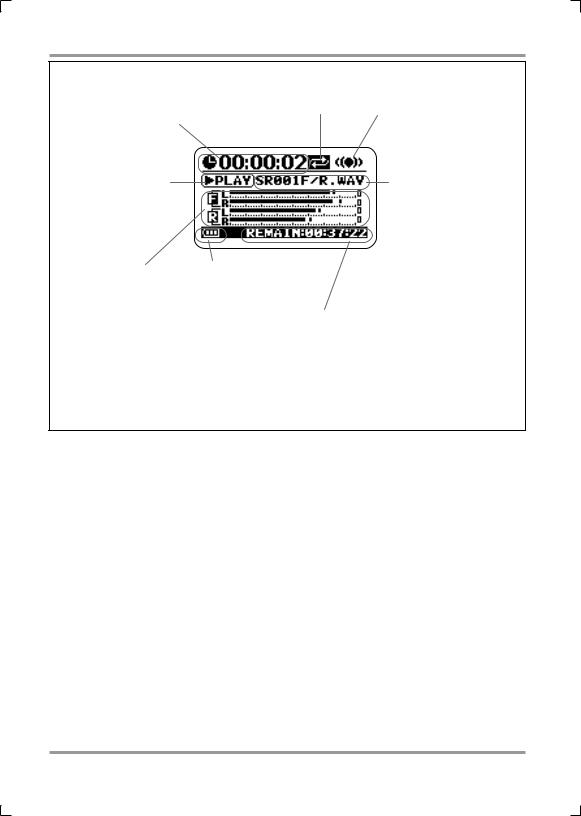
4-Channel Mode Recording
Counter
Shows the playback time of the current file or the recording time in hours/minutes/seconds.
Option function symbol
When repeat playback or auto record is active, the respective symbol is shown here.
4-channel mode symbol
Shows that the H2 is operating in 4-channel mode.
Recorder status
Shows the current operation status of the recorder. There are five different indications for playback, pause, stop, recording standby, and recording.
Level meters
Indicate the current input level or output level. At the rightmost end of the scale is a clip indicator which lights up when signal clipping (leading to distortion and sound breakup) occurs. If clipping has occurred at least once during playback or recording, the clip indicator remains lit until the end of playback/recording.
Battery indicator
Shows the battery status.
Remaining recording time
Indicates the available time for recording, according to the currently selected recording mode (file format, quantization, sampling frequency).
File name
Normally, the name of the file pair that is played back is shown here. During recording standby and recording, the name of the file pair used for recording is shown.
In 4-channel mode, two WAV format files (one each for front and rear) are handled as a set. The indication "SRxxxF/R.WAV" (where xxx is a number from 000 to 499) refers to the front stereo file "SRxxxF.WAV" and rear stereo file "SRxxxR.WAV" pair.
28 |
ZOOM H2 |
